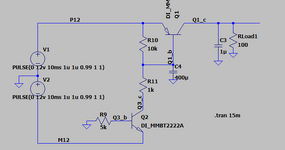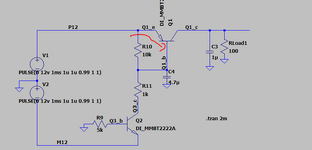yefj
Advanced Member level 5

- Joined
- Sep 12, 2019
- Messages
- 1,539
- Helped
- 1
- Reputation
- 2
- Reaction score
- 5
- Trophy points
- 38
- Activity points
- 9,267
Hello,The circuit is supposed to delay the output of P12 because the PNP is opening gradually.
In previos version it worked great but i put P12 as a pulse and circuit just not working.
The Veb is totally different.Veb is supposed to be 0 and rise gradually.
But when i made P12 0-12V pulse my Veb is tottaly ruined.
How can i fix it so Veb will rise gradually from 0 till PNP is opening?
LTSPICE file is attached.
Thanks.
In previos version it worked great but i put P12 as a pulse and circuit just not working.
The Veb is totally different.Veb is supposed to be 0 and rise gradually.
But when i made P12 0-12V pulse my Veb is tottaly ruined.
How can i fix it so Veb will rise gradually from 0 till PNP is opening?
LTSPICE file is attached.
Thanks.
Attachments
Last edited:








